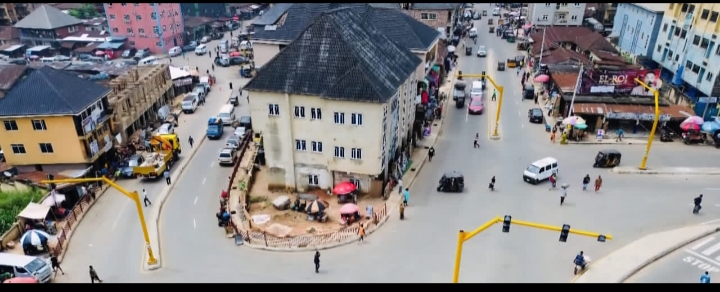Oluebube A. Chukwu

The hum of vehicles, the buzz of tricycle operators, and the ceaseless activity of pedestrians are the defining rhythms of Umuahia, the capital of Abia, God’s own State. Yet, for many years, these rhythms were disrupted by the absence of one critical element: functional traffic lights. What ought to have been a basic feature of modern urban life became a casualty of neglect, abandoned after half-hearted attempts by past administrations.
Today, that reality has changed. Governor Alex Otti’s administration has brought back the traffic lights, not as a cosmetic gesture, but as a working system that restores order and efficiency to the state capital. The reintroduction is more than a technical fix; it represents a bold breakthrough in governance, signaling the governor’s determination to confront challenges that once left others defeated.
Abians recall how traffic lights were first introduced under previous administrations as part of efforts to modernize Umuahia. The initial excitement, however, was quickly replaced with frustration. Technical hitches, poor maintenance, lack of political will, and in some cases outright neglect ensured the systems failed. Attempts to revive them were met with confusion, and when challenges mounted, the government of the day simply chickened out, abandoning the initiative.

The result was predictable: road intersections plunged into chaos. Motorists developed their own informal rules, sometimes enforced by brute force, while pedestrians risked life and limb crossing roads without protection. Traffic officers struggled with manual control, but human effort could not match what well-managed infrastructure would have achieved. It was a sad testimony of governance without courage.
In contrast, the Dr Alex Otti administration has approached the issue differently. Rather than seeing the failed traffic light project as a political landmine, he embraced it as a challenge to overcome. His team undertook technical reviews, consulted experts, and invested in modern facilities capable of sustaining the system over time.
The outcome is visible today. Umuahia’s intersections are once again dotted with working traffic lights, glowing green, amber, and red with reassuring rhythm. For residents who once doubted whether they would see such order in their lifetime, the sight is both symbolic and practical. It is a reminder that governance, when driven by vision and determination, can resolve long-standing urban problems.
The immediate benefit of the restored traffic lights is the improvement in traffic management. Intersections once marked by endless blaring of horns now flow with more predictability. Commuters can plan their movements with greater certainty, while pedestrians, including school children and the elderly, feel safer navigating crossings.
Commercial drivers, who often bore the brunt of road chaos, acknowledge that while adjustment takes time, the lights have reduced confrontations. Fewer arguments break out at junctions because the impartial signal dictates who moves and who waits. The ripple effect is already evident in reduced travel time, lower stress levels, and a calmer urban environment.
Globally, traffic lights are not mere utilities but essential pillars of urban development. In Kigali, Rwanda’s capital, traffic light systems complement the city’s famed cleanliness and order, reinforcing its reputation as one of Africa’s most organized cities. Similarly, Accra, Ghana, has embraced traffic signalization as part of a wider plan to decongest the city, proving that African cities can adopt world-class solutions when leadership prioritizes efficiency.
Beyond Africa, the importance of traffic lights is embedded in the DNA of advanced societies. In the United States, they are the backbone of road safety, saving countless lives annually by regulating vehicle flow. In the United Kingdom, the strict adherence to traffic signals underpins the country’s road culture, while in Germany, where traffic engineering is advanced, lights are seamlessly integrated with smart technologies that respond to real-time conditions. These examples implies that functional traffic lights are not luxuries but necessities for modern cities, large or small.
For Abians, the reintroduction of traffic lights carries symbolic weight beyond road management. It reflects a government willing to tackle challenges head-on, to do what others feared or failed to do. It also sends a message that governance is not about avoiding difficulties but about providing solutions, even when the odds seem stacked against success.
Dr. Alex Otti’s decision aligns with his broader philosophy of rebuilding Abia from the ground up. By fixing something as basic as traffic lights, his administration restores trust in government’s ability to deliver. It shows that attention to detail in governance translates into tangible improvements in the daily lives of citizens.
Traffic lights alone cannot solve all of Umuahia’s urban challenges. But they represent the first step in a larger conversation about modernizing Abia’s infrastructure. Functional traffic systems can open doors to further innovations such as synchronized lighting, pedestrian-friendly crossings, and integration with smart city technologies.
Moreover, with functional traffic lights, Abia can better prepare for increasing vehicular growth as its economy expands. Investors and visitors take cues from seemingly small details; a city where road traffic is chaotic creates doubts about governance, while order at intersections conveys seriousness and progress.
The return of traffic lights has been met with applause from residents. Traders at Isi Gate, one of the busiest junctions, report improved movement of goods, while schoolteachers welcome safer crossings for their pupils. Road safety advocates hail the initiative as a win for both motorists and pedestrians.
Transportation experts note that sustained success will depend on maintenance, enforcement, and public education. Without these, even the most advanced systems risk falling into disrepair. The Otti administration has reportedly taken steps to ensure sustainability, including setting aside resources for maintenance and engaging traffic officers to monitor compliance.
Perhaps the greatest long-term impact of the reintroduced traffic lights is cultural. Abia’s road users, long accustomed to improvising, are being nudged toward greater discipline. The lights, impartial and non-negotiable, demand respect for order. Over time, this could reshape civic culture, instilling a sense of responsibility that transcends the roads and extends to other aspects of public life.
The reintroduction of traffic lights in Umuahia is more than an infrastructural fix, it is a bold breakthrough that redefines governance in Abia. His Excellency, Governor Alex Otti has achieved what his predecessors could not: confronting a neglected challenge and delivering a practical solution. The benefits are already visible in smoother traffic, safer crossings, and restored public confidence.
In a world where cities rise or fall by the quality of their infrastructure, Umuahia now takes its place among capitals that embrace order and progress. And while the blinking lights may seem ordinary to some, in Abia they symbolize something extraordinary: the return of a government that works.
Oluebube A. Chukwu Ph.D, writes from Umuahia.




